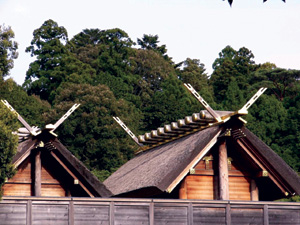Ise Jingu, otherwise known as The Grand Shrine is perhaps “The most venerated Shinto shrine in Japan” (Taylor, 1997). Found in the city of Ise, in modern day Mie prefecture, Japan, Ise Jingu is in fact a large complex of shrines set in an awe inspiring natural setting of a great cedar forest. The complex is centred around two main parts: Naiku (the inner shrine) and Geku (the outer shrine), these are considered the most holy shrines of the Shinto religion. Access is strictly prohibited to the common public, who by peering over tall wooden fences will see little more than the thatched roofs, however, similar architecture is seen in numerous subsidiary shrines found throughout the complex.
The shrine complex of Ise Jingu follows the basic principles of Shinto architecture, and is a perfect example of how core values and cultural beliefs influence the choice of building materials, techniques and designs within Japanese architecture and design. Belonging to a special architectural style known as shimmei-zukuri, the two main shrines are “simple and archaic structures”, deriving from raised prehistoric rice stores. The main buildings are made of exposed, unpainted wood with thatched roofs. The simplicity of their design and the preference for only natural materials, together with the shrine’s natural setting, reflects the Shinto belief of there being a divine power within nature; it “permeates everything but is more highly concentrated in some things, such as waterfalls, trees and animals” (Young et al, 2004).
However, in addition to these hallmark characteristics of Japanese architecture, what is more significant about making of Ise Jingu is the fact the two main shrines are destroyed and rebuilt to exacting specifications every 20 years! In this way the shrines remain forever ancient and original but, at the same time, are forever new, “representing the Shinto concept of nature which is always renewed and reborn”.
It is this regular renewal that enables the preservation of its unique architectural style.
“The rebuilding is done mainly by local carpenters, who set aside their usual work for this privilege for two to four years. There are plans which have been handed down regarding the rebuilding of each shrine, but in addition to this is it vital that the master carpenters teach the apprentices the steps taken in rebuilding the shrines, as the tools and methods used have been passed down from ancient times. No nails are used at all in the process of rebuilding.” (http://www.yamasa.org/japan/english/destinations/mie/ise.html.
It is this practice that has led me to conclude that Ise Jingu may be more appropriately categorised in the area of craft.
